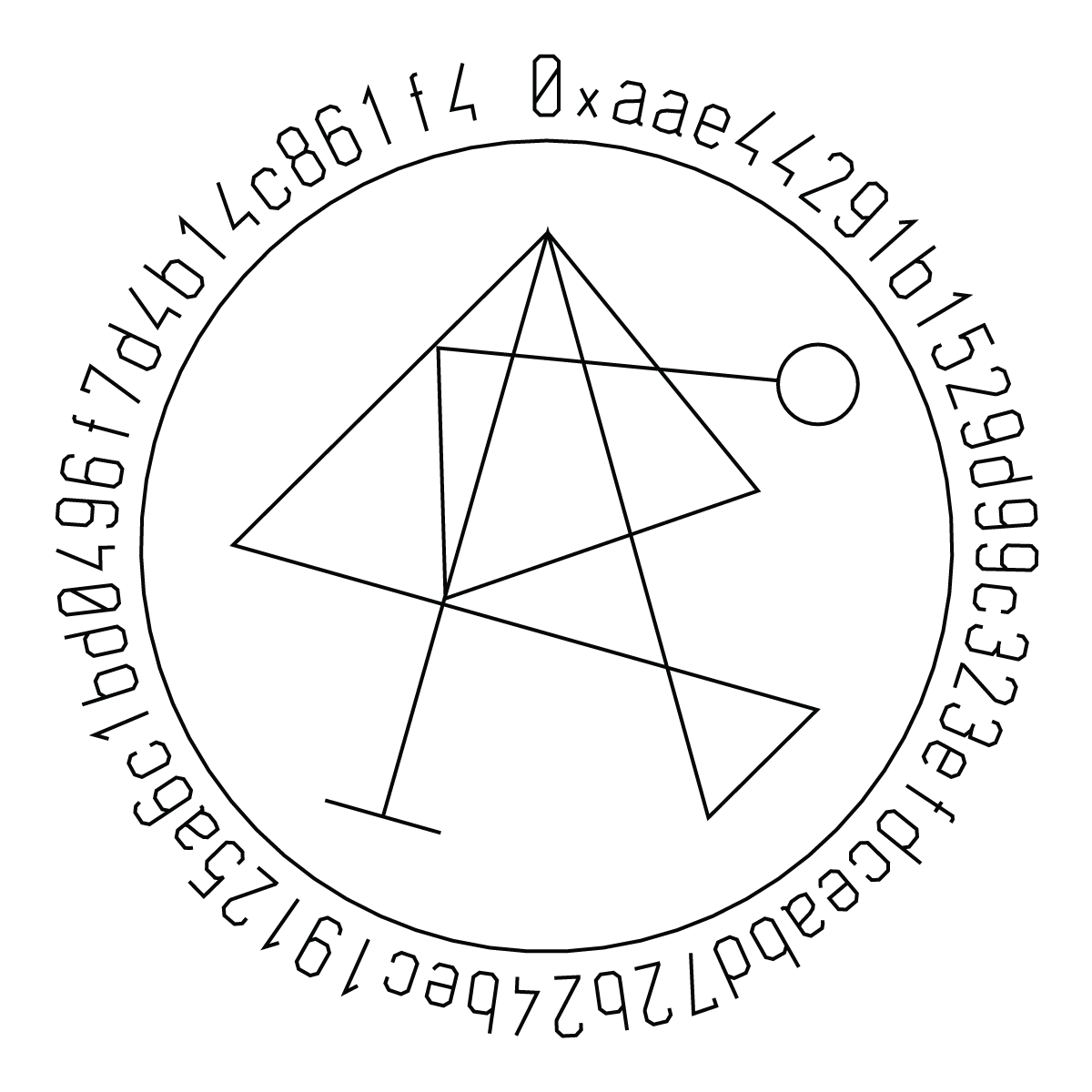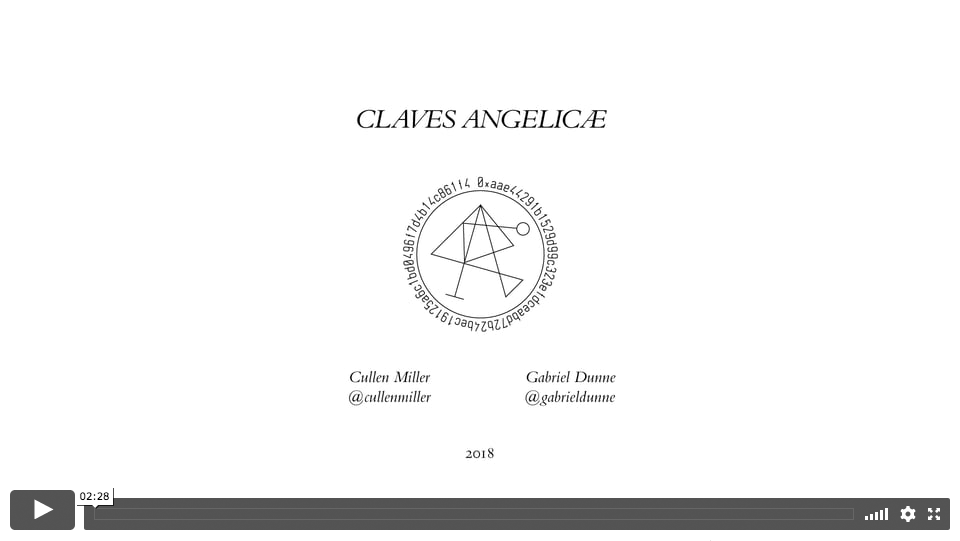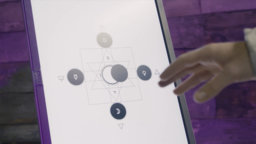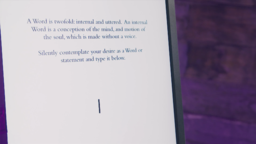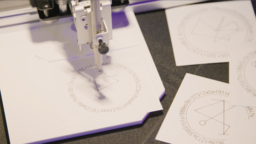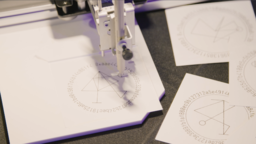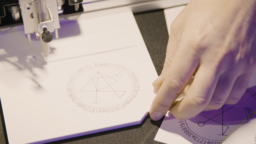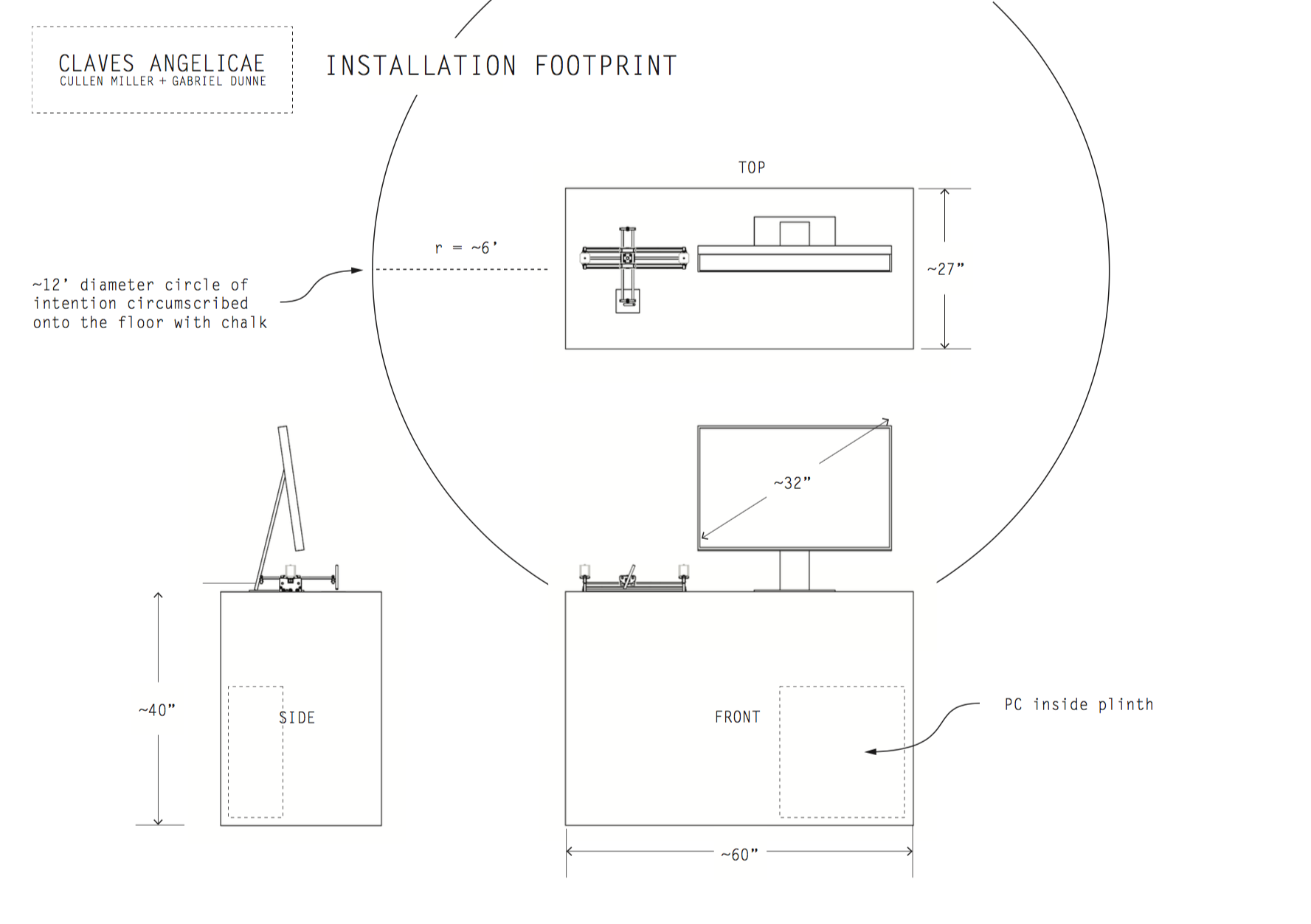
March, 2018
Claves Angelicæ is an installation and procedural system that enables a participant to inscribe a magical Word onto the Ethereum network.
The seven step process is designed to collect and transmute the participants’ input data into an encrypted message. For the participant to cast their Word they must transmit Ether to a preselected set of charities. Once the spell has been cast and verified by the consensus pool, the transaction signature’s hash is returned, parsed, and passed into a sigil generating algorithm. The participant receives an inked paper talisman authored by an mechanical drawing machine as a tokenized sigil of their spell.
Cryptography and magic have a deep, intertwined history dating back to the origins of writing. During the European dark ages monastic sects bore the responsibility of keeping the rites of the sacred ancient mystery cults of Egypt and Greece intact. However, in doing so they ran the risk of being burned at the stake for committing crimes of heresy. Some of them developed cryptographic systems to encode these secrets into their manuscripts.
Trithemius, a Benedictine abbott, cryptographer, and occultist, authored the tripartite tome Steganographia, a seminal codex in the history of cryptography. Trithemius’ preface to the Polygraphia establishes the practicability of cryptography as a “secular consequent of the ability of a soul specially empowered by God to reach, by magical means, from earth to Heaven.”
It was not only monks working with ciphers but also natural magicians and occultists. The latter groups weren’t only using cryptography to obfuscate sensitive information, but also to devise keys and linguistic frameworks for communicating into the ethereal realms. By devising new linguistic schemata these magicians believed that they could access the preternatural realms outside the worlds they were exploring in their scientific pursuits. Although the blockchain space is largely secularized, the principles of the Ethereum network are a manifest dream of the ancient magi. Magicians are the original cypherpunks.
Solidity is a grimoire (Latin grammaire) or book of magical grammar. Smart contracts are dæmons invoked to enact our Will. Pentacles are cryptographic tokens for binding dæmons and storing value. Magical codes of ethics are emblematized in protocol authorship. DAOs are Enochian Irim (egregores): emergent entities formed by groups of magicians collectively constructing a shared, single thought. Salt, an alchemical primes, is a cryptographic primitive that serves as random data used as an additional input to a one-way function encrypting the message. Sigils are graphical databases used for storing enciphered information.
For common parlance let’s define what a sigil is: the encoding of desire or intent into a symbol. The Latin sigillum, means ‘seal’, likely derived from the Hebrew הלוגס (segula) meaning ‘word, action, or talisman’. Common examples of crypto-sigils are Johannes Trithemius’ experiments in Steganographia, Giordano Bruno’s mnemonic devices, John Dee’s Sigillum Dei Aemaeth, and innumerable others.
Centralized authorities and trusted third-parties (churches & banks) shape our cultures into monotheistic tendencies (e.g. “In God We Trust”) where priests or bankers arbitrate and broker access to the value system. Whereas decentralized systems allow for a plurality of deities to inhabit the Ether and entrust magicians to enact their Will without permission.
Video
Images
Experience
i. Initiation
Claves Angelicæ is a seven step process to guide one through the process of securely constructing a Word with an ‘Alphabet of Desire.’ This Alphabet of Desire is a mediation with one’s own libidinal framework. Magic has many aspects, but it primarily acts as a dramatized system of psychology. It is the science and art of causing change to occur in conformity with one’s Will. A magical spell is quite literally the spelling out of a Word. Once the Word is constructed within oneself it is set in motion by bringing it forth into grammar and sound. When completed one must seal it and cast it out into the Ethereum network.
ii. Banishing
Within each self there is a natural fortress: the Soul impregnable. However beyond this central citadel, one also has outerworks which are vulnerable and susceptible to violation. Banishing rites are twofold: Firstly, it provides a cleansing and maintenance of the walls of the fortress. Secondly, it operates as a firewall for the body and the space surrounding it. This allows for secure outbound transmissions of magical Words (spells) while fortifying and consecrating the Magician in a bastion away from exploits and malicious attacks.
iii. Logos
“In the beginning there was the Word (Logos).” A Word is twofold: internal and uttered. The internal Word is a conception of the mind, and motion of the soul, which is made without a voice. The Word is to be silently contemplated. The Logos is the generative principle which impregnates potentiality. The semiotics of magic are thus: the map is not the territory. The Name is the thing itself.
iv. Incantation
The Word is twofold: internal and uttered. An uttered word is the internal Word brought forth through breath into vibration. Through this act of locution the Will sets the Word in motion. Incantation is derived from the Latin incantare meaning “to enchant, cast a spell.” The infamous magical word ‘Abracadabra’ is derived from the Aramaic meaning “I create as I speak.” Language operates as the material mediation between subconscious desires and the conscious mind. The Word is the Will encoded into a substrate for transmission. It is through incantation that the Word is set in motion.
v. Seal
Sealing is the act of encrypting a message. A sigil is the encoding of desire or intent into a symbol. The Latin sigillum means ‘seal’. The Hebrew הלוגס (segula) meaning ‘word, action, or talisman’. The sigil traces the paths of the majestic alphabet of the ancient magi with the Rosy Cross as its key.
vi. Casting
Once the Word has been synthesized and prepared for secure transmission on the network it must be activated by casting it out. Once the spell is cast a smart contract daemon is invoked to route the Word to its destination. This destination address is assigned by selecting a cardinal direction to where the Word is to be cast. After the spell is completed the Word is inscribed onto the distributed ledger of the Ethereum network.
vii. Sigil
The daemon listening for the cryptographically signed acknowledgement of transfer is animated to draw the Sigil onto a paper talisman with a mechanical writing machine when it can verify that the Word has been authored. The Sigil is both sign and signifier of the encrypted Word’s transaction record on Ethereum’s public ledger.
Sigil
Sigils are generated with a graphical encryption algorithm based on the Rosy Cross.
- Word is entered in by the participant.
- Word is hashed with sha256 function
- Every 10th character of the hash is appended to a new string until the string is 10 chars long.
- This 10-char string is used to trace a graphical sigil with the Alphabet of Desire, as shown below:
Installation Format
Physical installation comprises of a podium within a 12’ chalk circle.
Experience Requirements for Attendees
In order to cast their Word or desire to Ethereum’s distributed ledger and complete the experience, the participant is required to prepare and be familiar with using a mobile wallet that allows them to send an amount of Ether that, at minimum, covers the costs of the transaction, which will vary depending on the network load. Some mobile Ethereum wallet solutions include Trust Wallet, Toshi, Ethereum Wallet by Freewallet, Coinbase, and more.
Installation Rider / Requirements
- Dedicated internet connection
- Power drop (1x 120v AC)
- Folding table with 2x black chairs and black tablecloth
- Installation area with floorspace of minimum 14 sq feet
Collective Statement
Gabriel Dunne and Cullen Miller are collaborators often found working within the confines of art. Respectively drawing from their backgrounds in design and music composition their practice is an assemblage of various forms of media finding mutuality in a search for the Outside.
Their projects and performances are typified by creating technical systems that defy bounded rationality. Their work probes into subconscious immaterial processes by leveraging computational materials as a vehicle into complexity. Their aesthetics are typically not constrained by a controlled practice but, rather, tend to be emergent unknowns retrieved from systems. Rather than setting forth to construct a preordained form their practice typically involves tending generative machine processes as a way of excavating ideas from the Outside.
Credits
Created By
Interactive programming
Harvey Moon
Documentation Photography / Video
Eric Fernandez
Created with
Ethereum, Solidity, Python, JavaScript, Node.js, TouchDesigner, Leap Motion, EMSL AxiDrawV3
Assets
- Info Sheet (PDF)
- Links and Description (TXT)
- Links and Description (RTF)
- Framing and Display Spec (PDF)
- Installation (PDF)
- Interaction Flow (PDF)
- Sigil Encryption (PDF)
- Logo (Black)
- Logo (White)
- LogoType (Black)
- LogoType (White)
Exhibition History
- 2018 May 11, Ethereal Summit, Brooklyn NY USA
- 2018 June 23, Distributed Systems, San Francisco CA USA
- 2018 Oct 22, Web3 Summit, Funkhaus, Berlin Germany
- 2018 Nov 17, {PERFECT & PRICELESS}, Kate Vass Galerie, Zurich Switzerland
NFT
- 2021 Dec 16, Claves Angelicæ NFT
Project Support
ETH: 0xBd78EB42c0A6db5EcD523Ce794c2B66aF3874ceF
